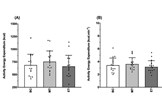Does using a trolley reduce the health benefits of golf?
Published: Last updated:
New research into the calorific effects of carrying versus carting your clubs may surprise you.
My on-course sustenance typically includes a Mars bar, a bottle of Coke, and the unavoidable bacon roll at the halfway house.
I make it around 700 calories, but who’s counting?
Well, a team of sports scientists from Liverpool John Moore’s University, actually.
Great news, I can now bask in club-carrying smugness and level with my conscience that at least one beer has been earned for my heroic exertions.
“No, not at all, says Professor Graeme Close, who led the research team.
“The amount of calories we are burning while we play is the same, regardless of if you’re carrying, pushing, or using an electric trolley.”

In Prof Close’s study, published in the European Journal of Sports Sciences (Kasper et al., 2023), 16 highly skilled golfers were shown to expend the same amount of energy regardless of how they transported their clubs around the course.
Observed differences in activity energy expenditure across 18 holes were shown to be negligible when comparing carrying clubs (688 kcal), to using a push trolley (756 kcal), to using an electric trolley (663 kcal).
Based on my mid-round eating habits, I’m about level par on the calorie front then!
The finding that energy expenditure for a round of golf is around 3.5 calories per minute, irrespective of club transportation mode is undoubtedly the major finding of this study and was contrary to the team’s original hypothesis, and most likely many club golfers too!
“Our results suggested that by far the major contributor to the energy expenditure of golf is walking itself. The act of striking the ball, or carrying the clubs, is a much more minor contributor than walking”, added Close.
So where do I go from here? Ditch the stand bag, or ditch the Mars bar? The bacon roll is non-negotiable.

The calorie conundrum
Calories are a measure of energy, and if we consume less than we burn, we enter a calorie deficit, which over time is the mechanism for weight loss – or gain, if we enter a calorie surplus.
So, if you choose to carry your clubs in pursuit of a weight loss goal, then perhaps this study provides some evidence to make you re-think, particularly if you find carrying a bag an arduous and unenjoyable task.
That said, we must acknowledge that this study was conducted with highly skilled, academy golfers – not Willy, Wilma, and Wilfred from the Tuesday morning swindle.
We can’t speak to individual fitness levels, however, differences in energy expenditure may be more pronounced in the general population as we typically end up walking further due to our creative navigation around the course.
Add to that, the tendency of young high-level golfers to carry uber-lightweight pencil bags with a half set of clubs, and suddenly, the results become slightly less clear-cut to the wider golf community.

That’s not to say the results are less valid, however. They are a useful starting point to a question that warrants further investigation.
For example, as the total distance walked during each round was not directly measured, the authors had to assume these golfers would have all traveled relatively consistent distances in each of their three rounds.
Of course, the most controlled way of performing this test would be in a laboratory setting, whereby players hit a set number of shots into a net, interspersed with prescribed walking distances on a treadmill.
To preserve ecological validity, however, the authors opted for a ‘real-world’ setting which is to their credit, despite making some key variables tricky to control.
It’s why seeing these tests repeated with different groups of the general golfing population, and perhaps on a more undulating course would be very interesting.

Wider health implications
Despite no meaningful differences in calorific requirements between the three modes of transport, a measure of perceived exertion (RPE) showed that even high-level golfers perceived carrying their clubs to be significantly harder than using an electric trolley.
Average heart rate data, additionally collected as part of the study, supported the golfer’s RPE scores, with the lowest heart rates reported from the rounds using electric trolleys.
This finding raises the more poignant question of whether carrying clubs could contribute to other beneficial long-term health implications that strength training studies have demonstrated in the literature.
These include, but are not exclusive to lowering injury risk, improved heart health, decreased risk of falls, greater mobility, and making it easier to perform daily tasks requiring strength.

While carrying a 10-12 kg bag for a few hours may seem a stretch to compare with following a structured strength and conditioning program, for some, it might represent the only time in the week that their muscular-skeletal system is stressed.
And for older golfers, maintaining muscle mass into later life is hugely important.
After all, safely loading clubs onto your back for 18 holes will likely see you lift and lower the weight in the region of 150 times.
That’s 15 sets of 10 repetitions, not to mention the potential strength endurance improvements received in localized muscle groups by effectively increasing your body weight by approximately 10%.
And while this study has shown energy expenditure to be negligible between transportation modes, it did not track post-activity metabolism which has been shown to continue burning calories for 72 hours after strength training ceases.
While this was not the aim of the present study, dedicated inquiry into how efficient carrying a golf bag is as a form of strength training would certainly be of interest to the golf community.

What about performance?
The heart rate data showed carrying a bag to elicit the widest range of beats per minute across the three rounds, and also the highest overall heart rate of 144 bpm.
It’s not possible from this evidence to speculate about the effect of heart rate variability on golf performance, but anecdotally, we would all rather not be facing a delicate chip or hole-winning putt whilst trying to control a thumping heart rate.
“I guess what we all want is to be nice and calm and controlled over the ball, added Prof Close.
“I mean, I don’t know if I ever will be if I’ve got a 4-footer to win my club comp at the weekend… but yes, what we don’t want is the heart rate being spiked by the activity, we want to give ourselves every chance of being calm and making that putt!”

While switching your straps for the latest remote-controlled trike is unlikely to see your handicap tumble overnight, the authors here have presented the most robust evidence yet that ‘the walk’ itself is the major contributor to recommended government exercise targets, not your method for transporting clubs.
Needless to say, if carrying a bag for 18 holes causes muscular fatigue or niggles that mean you have to increase recovery time between rounds, then you should be considering a trolley.
Getting on the course as often as possible is the aim of the game, and no matter how your bag makes it to the finish line, finding your ideal balance of enjoyment, exercise, and competition is the only real thing that matters.
Not forgetting the bacon roll of course!
*The full study can be accessed here.
BECOME A TODAY’S GOLFER MEMBER: Unlimited access to premium content and exclusive rewards!
About the author

Ross Tugwood
Golf Equipment Writer
Ross Tugwood is a golf equipment writer for todays-golfer.com, specializing in data, analytics, science, and innovation. He’s also an expert in golf apparel and has a keen interest in sustainability.
Ross is passionate about optimizing sports performance and has a decade of experience working with professional athletes and coaches for British Athletics, the UK Sports Institute, and Team GB.
Ross uses a Cobra King SZ Speedzone driver, Titleist TSi2 3-Wood, TaylorMade Sim2 Rescue, Callaway Apex Pro irons (4-PW), Cleveland 588 RTX wedges (52°, 58°), TaylorMade Spider Ex putter, and a TaylorMade Tour Response golf ball.
-
 Liverpool John Moores University measured the physical effects of transporting golf clubs on the body.
Liverpool John Moores University measured the physical effects of transporting golf clubs on the body.
-
 Effects of bag transportation on energy expenditure (from Kasper et al., 2023).
Effects of bag transportation on energy expenditure (from Kasper et al., 2023).
-
 Effects of bag transportation on perceived exertion (from Kasper et al., 2023).
Effects of bag transportation on perceived exertion (from Kasper et al., 2023).
-
 More research is needed to understand energy expenditure in general golf populations.
More research is needed to understand energy expenditure in general golf populations.
-
 The authors conducted the research in a real golfing environment for ecological validity.
The authors conducted the research in a real golfing environment for ecological validity.
-
 Could trolley users be forfeiting other potential health benefits?
Could trolley users be forfeiting other potential health benefits?
-
 Further research is needed to explore the link between heart rate and golf performance.
Further research is needed to explore the link between heart rate and golf performance.
-
 Using an electric trolley burns a similar amount of calories to carrying your bag.
Using an electric trolley burns a similar amount of calories to carrying your bag.
